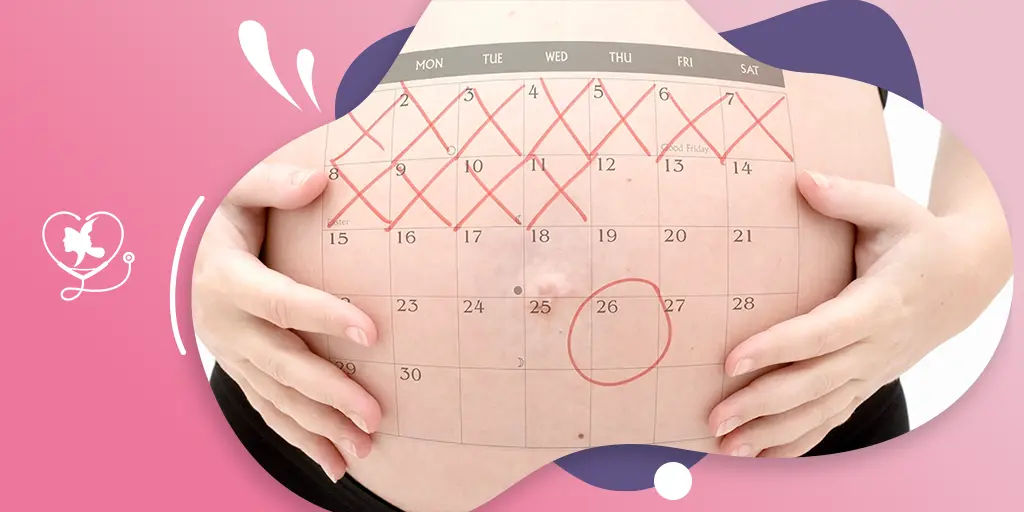A due date calculator can be a helpful tool for estimating the likely date of your baby's birth. By calculating your due date, you may gain some insight into the likely timing of your baby's birthday. However, it's important to remember that your due date is only an estimate. In reality, only about 4% of babies are born on their due date.
What is a Pregnancy Due Date?
Your due date is the date on which you are expected to give birth based on the 38-week process of fetal development. It takes approximately 38 weeks (266 days) for a fetus to develop to full term.
Just a friendly reminder: Babies can be born at any time! There are so many factors that play a role in determining when you go into labor and when your little one will make their grand entrance.
Methods to Calculate Pregnancy Due Date
- Using the Last Menstrual Period (LMP)
It is believed that the notion of a pregnancy lasting for 40 weeks or 280 days may have originated with the German obstetrician Franz Naegele (1778–1851). His guideline suggests adding nine months and seven days to the first day of the last menstrual period.
This is the most common way healthcare providers can calculate your pregnancy due date by counting 40 weeks from the first day of your last menstrual period (LMP).
To use the Naegele formula, simply follow these steps:
- First, determine the first day of your last menstrual period.
- Second, count back three calendar months from that date
- Third, add 1 year and 7 days to that date.
For example, your last menstrual period began on June 9, 2024. Counting back 3 calendar months would be March 9, 2024. Adding 1 year and 7 days would bring you to March 16, 2025, as your estimated due date.
- Using Conception Date
If you have been monitoring ovulation symptoms or have been using ovulation test strips, you may be able to use your conception date to determine your gestational age and the estimated date of delivery. To determine the estimated due date, simply add 266 days.
For example, using the 28-day cycle, and assuming that the conception date is November 1, 2024, your date will be August 10, 2025.
- Using Ultrasound Scans
Calendar calculations that are based on the last menstrual period assume that the pregnant woman has a regular 28-day menstrual cycle. This is often not the case. Therefore, fetal ultrasounds provide more information to estimate due date. This ultrasound is used to calculate the estimated gestational age and estimated due date (EDD) of the fetus.
In most cases, doctors compare the EDD determined by ultrasound to the EDD determined by the last menstrual period.
- IVF (In Vitro Fertilization) Due Date Calculation
IVF (in vitro fertilization) is a type of fertility treatment where eggs and sperm are combined outside of the body in a laboratory setting. It is a method that may be helpful for those who are struggling to achieve pregnancy. IVF is a complex process that has proven to be an effective form of assisted reproductive technology (ART).
If you've had an IVF transfer, you can use that date to figure out when you're likely to give birth:
- If your clinic transfers the embryos 5 days after egg retrieval, you'll need to count ahead for 261 days from the transfer date.
- If your clinic transfers the embryos 3 days after egg retrieval, you'll need to count ahead 263 days to determine your due date.
As with the other methods for calculating your due date, it's always best to check with your provider to confirm your due date.
Adjusting the Due Date
When a doctor does an ultrasound, they write up a report on what they found and include two estimated due dates. The first date is based on the date of the last menstrual period (LMP). The second date is based on the ultrasound measurements. These dates are rarely the same, but don't worry! As we mentioned earlier in this guide, babies are rarely born on their estimated due date.
When your doctor looks at the ultrasound results, they'll decide if these dates match up. Your doctor probably won't change your due date unless it's a lot different from your ultrasound date.
Each ultrasound report will show a new due date based on the latest measurements if you have more ultrasounds. It's generally not a good idea to change the expected due date based on measurements from a second or third-trimester ultrasound.
Pregnancy Trimesters and Milestones
The fetus undergoes many changes during a typical pregnancy. This time is divided into three stages called trimesters. Each trimester lasts about three months. Your healthcare provider will probably talk to you about your baby's development in terms of weeks. So, if you're three months pregnant, you're about 12 weeks along.
During each trimester of pregnancy, you'll see distinct changes in the fetus and in yourself.
First Trimester: from conception to 12 weeks.
The first trimester is from conception to 12 weeks. This is usually the first three months of pregnancy. This is when the fertilized egg grows from a small group of cells to become a fetus that begins to take on human characteristics. The first trimester is exciting, but it is also when most people develop uncomfortable symptoms such as morning sickness and tiredness.
After 12 weeks (the end of the first trimester), your risk of miscarriage drops significantly because the most critical development has taken place. This is also when most people begin to feel some relief from their morning sickness.
By the time three months have passed, your little fetus is already about 2.5 to 3 inches long! That's about the size of a plum.
Second Trimester: from week 13 to week 28
Often considered the best part of pregnancy, the second trimester is the most comfortable. By this time, any morning sickness is likely to be over and the discomfort of the early stages of pregnancy has faded.
You may also begin to feel movement as the fetus flips and turns inside your uterus. It is during this trimester that many people find out the sex of the fetus. This is usually done during an anatomy scan (an ultrasound scan that looks at physical development) at about 20 weeks.
Third Trimester: from week 29 to week 40
This is the final stage of your pregnancy. It's tempting to count down the days until you're due, hoping for an early delivery, but each week of this final stage of development helps the fetus prepare for delivery.
Throughout the third trimester, the fetus gains weight quickly, adding body fat that will help after birth. The fetus is about 45 to 50 centimeters long and weighs about 3 to 4 kilograms.
How Accurate is the Due Date?
Your baby might start testing your patience before they even arrive! Most babies arrive before or after the due date you've excitedly written down or circled on your wall calendar. There are a few things that can affect your due date, either making it come a little early or a little late.
There is a greater possibility of going into labor before the estimated due date if you:
- Are carrying multiples (twins, triplets)
- Have anatomical differences, including shorter cervix
- Under the age of 18 or over the age of 35
- Have certain medical conditions (diabetes, blood pressure)
- Have certain infections.
On the other hand, there is a greater possibility of going into labor after the estimated due date if you:
- First-time mother
- Are over the age of 30
- Are clinically overweight
- Were born post-term
Key Takeaways
- Due date estimations are not 100% accurate, in reality, only about 4% of babies are born on their due date.
- There are different formulas you can use to figure out your due date, but it's always a good idea to run the results by your healthcare provider.
- There are a number of factors in your body that can either lead to an early or delayed due date.






.webp)
.webp)
.webp)
.webp)

